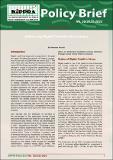Policy Brief No. 26 of 2023-2024 on Addressing Digital Credit Burden in Kenya
| dc.date.accessioned | 2023-11-23T13:40:05Z | |
| dc.date.available | 2023-11-23T13:40:05Z | |
| dc.date.issued | 2023 | |
| dc.identifier.uri | https://repository.kippra.or.ke/handle/123456789/4646 | |
| dc.description.abstract | Digital credit1 has expanded in popularity in the past ten years following the growth of financial access, from 40 per cent in 2009 to 84 per cent in 2021.2 The credit ratio also significantly increased from 50 per cent in 2019 to 60 per cent in 2021 despite a substantial decline in usage of digital loan applications (apps) from 8.3 per cent in 2019 to 2.1 per cent in 2021. The decline in using digital loans, compared to other loan platforms through this duration could be attributed to the resultant problems associated with digital loans. With increased access to Internet, mobile money is readily available, convenient, and the most convenient platform for any individual with a phone to effect payments and access credit and savings facilities. Despite the initial utilization of mobile money in making payments and money transfer services, mobile money has steadily revolutionized in Kenya to incorporate credit and savings functions. However, the mobile platform has not been fully utilized as a means of savings. Kenya experienced low increase in savings rate from 69.9 per cent in 2019 to 74 per cent in 2021, compared to the credit rate of 50.4 per cent to 60.8 per cent within the same duration | en |
| dc.language.iso | en | en |
| dc.publisher | The Kenya Institute for Public Policy Research and Analysis (KIPPRA) | en |
| dc.relation.ispartofseries | PB/26/2023-2024 | |
| dc.subject | Digital Credit | en |
| dc.subject | Financial Access | en |
| dc.subject | Digital Loan Applications | en |
| dc.subject | Mobile Money | en |
| dc.subject | Internet | en |
| dc.title | Policy Brief No. 26 of 2023-2024 on Addressing Digital Credit Burden in Kenya | en |
| dc.type | KIPPRA Publications | en |
| ppr.contributor.author | Michuki, Valentine |
Files in this item
This item appears in the following Collection(s)
-
Policy Briefs [165]




